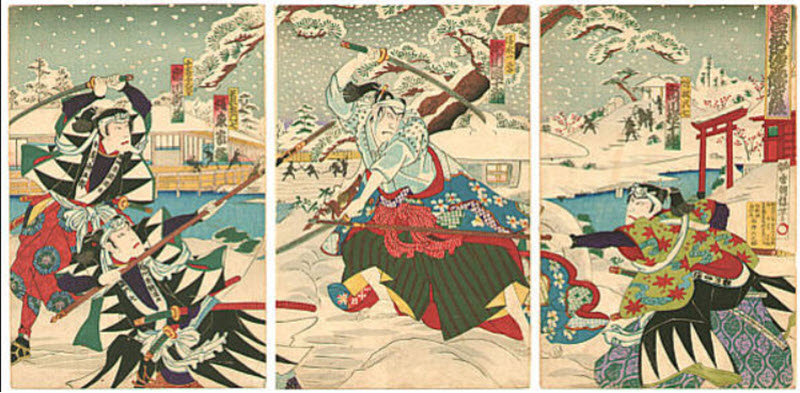Kana dehon Chūshingura (仮名手本忠臣蔵) is an 11-act bunraku puppet play composed in 1748, based on the 1701-1703 historical events known as the Revenge of the 47 Ronin.
Kana dehon Chusingura is one of the most popular and most frequently played of all Japanese plays.
The oldest known Chinese translation of the play is from 1794, while translations into English, German and French appeared in the late 19th century, when translations of Japanese texts into European languages was still a very rare thing. An English-language version by the British poet John Masefield was released in 1915 under the title “The Faithful”.
During the Allied occupation of Japan after World War II, the play was banned by the Supreme Commander of the Allied Powers as it allegedly promoted feudalism. The ban was lifted in 1947.

Authorship of Kana dehon Chūshingura
Early materials listed the authors of Kana dehon Chūshingura in order as:
- Takeda Izumo II
- Miyoshi Shōraku
- Namiki Senryū
The fact that several authors were involved might account for the notable changes that some characters go through during the play. Sagisaka Bannai does for instance provide comic relief early on the in the play, but by the seventh act he has turned into a stern and serious character.
It is generally believed that Izumo II worked with the overall plot and the acts 1, 4, 6 and 9, while Shōraku wrote the second, 10th and 11th act. This has been questioned though, e.g. by the author Jippensha Ikku (1765-1831).
What is bunraku?
Bunraku (文楽), also known as ningyō jōruri (人形浄瑠璃), is a form of traditional Japanese puppet theatre. It has its origins in early 17th century Osaka.
In a classic bunraku performance, there will be three kinds of performers:
- The puppeteers, known as Ningyōtsukai or Ningyōzukai.
- The chanters, known as Tayū.
- The musicians who play the three-stringed instrument shamisen. Compared to the shamisen used for kabuki theatre, the shamisen accompanying bunraku theatre tend to have a longer and thicker neck, to match the robustness of the bunraku music.
Bunraku shares many themes with kabuki (where human actors are seen on stage instead of puppets), and many plays have been adapted to suit both bunraku and kabuki. However, bunraku performers (puppeteers, chanters and musicians) follow the script in a much stricter fashion. Therefore, it is often said that bunraku is an author’s theater while kabuki is a performer’s theater. Historically, kabuki performers have been notorious for improvising, adding references to contemporary events and trying to boost the importance of their particular character in the play, sometimes to the annoyance of the author. Conversly, the chanter of a bunraku play will hold up the manuscript prior to the performance and bows before it, promising to follow it.
Background
The historical events upon which the play Kana dehon Chūshingura is based took place in 1701-1703 CE, and culminated with the killing of the court official Kira in late 1702 and the death of 46 ronin on 4 February, 1703 CE.
Just two weeks after the death of the ronin, a kabuki play titled Akebono Soga no Youchi (“Night attack at dawn by the Soga [Brothers]” opened in Edo, and was quickly shut down by the authorities since kabuki renditions of contemporary events were illegal and the play was seen as a disguised version of the 47 ronin event. From that point, in ordert to avoid further problems with the censors, the kabuki companies stayed away from plays that could be perceived as being about the 47 ronin.
Puppet-plays were not censored in the same way as kabuki, and the puppet-play troups had a bit more freedom to take on contemporary events. In 1706, i.e. just a few years after the death of the 46 ronin, the famous Japanese dramatist Chikamatsu Monzaemon (“the Shakespeare of Japan”) composed a three-act puppy play called Goban Taiheiki. Instead of placing the action in 18th century Japan, he placed it in the 14th century, probably to make censorship even less likely. The real-world court offical Kira’s name was changed to Moroano, and this – along with several other renamings – would later be picked up by other playwrights for plays about the 47 avenging ronin.
